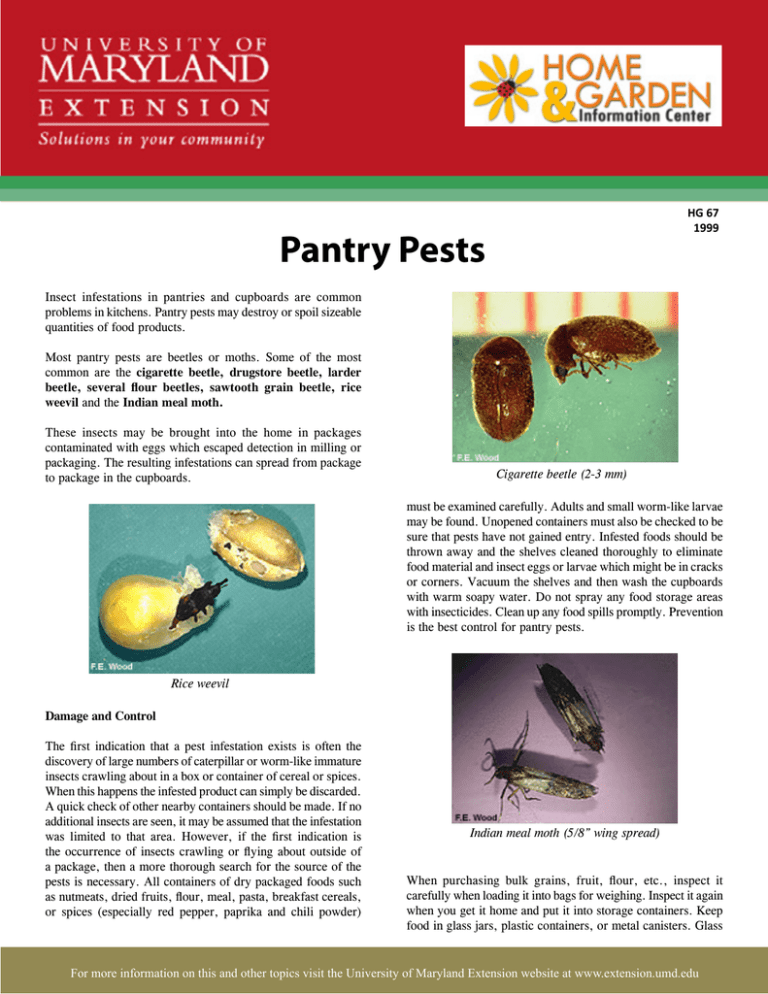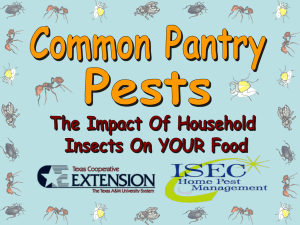Pantry Pests
advertisement

HG 67 1999 Pantry Pests Insect infestations in pantries and cupboards are common problems in kitchens. Pantry pests may destroy or spoil sizeable quantities of food products. Most pantry pests are beetles or moths. Some of the most common are the cigarette beetle, drugstore beetle, larder beetle, several flour beetles, sawtooth grain beetle, rice weevil and the Indian meal moth. These insects may be brought into the home in packages contaminated with eggs which escaped detection in milling or packaging. The resulting infestations can spread from package to package in the cupboards. Cigarette beetle (2-3 mm) must be examined carefully. Adults and small worm-like larvae may be found. Unopened containers must also be checked to be sure that pests have not gained entry. Infested foods should be thrown away and the shelves cleaned thoroughly to eliminate food material and insect eggs or larvae which might be in cracks or corners. Vacuum the shelves and then wash the cupboards with warm soapy water. Do not spray any food storage areas with insecticides. Clean up any food spills promptly. Prevention is the best control for pantry pests. Rice weevil Damage and Control The first indication that a pest infestation exists is often the discovery of large numbers of caterpillar or worm-like immature insects crawling about in a box or container of cereal or spices. When this happens the infested product can simply be discarded. A quick check of other nearby containers should be made. If no additional insects are seen, it may be assumed that the infestation was limited to that area. However, if the first indication is the occurrence of insects crawling or flying about outside of a package, then a more thorough search for the source of the pests is necessary. All containers of dry packaged foods such as nutmeats, dried fruits, flour, meal, pasta, breakfast cereals, or spices (especially red pepper, paprika and chili powder) Indian meal moth (5/8” wing spread) When purchasing bulk grains, fruit, flour, etc., inspect it carefully when loading it into bags for weighing. Inspect it again when you get it home and put it into storage containers. Keep food in glass jars, plastic containers, or metal canisters. Glass 1 For more information on this and other topics visit the University of Maryland Extension website at www.extension.umd.edu jars that pressure seal with rubber gaskets are the best. Make sure they have tight fitting lids. Many of the pantry pests are very small and can crawl under loose fitting lids. Do not store products in plastic bags, or cardboard boxes as the insects can chew through them. Try to store foods in a cool dry place. Most of the stored product pests multiply faster at higher humidity. Many products can be kept in the freezer to prevent infestation, especially products that are not used right away. Nuts, flours, meals, and dried chili peppers can all be frozen. ALWAYS READ THE PESTICIDE LABEL AND FOLLOW ALL DIRECTIONS AND SAFETY PRECAUTIONS. PROTECT THE BAY. USE PESTICIDES AND FERTILIZERS WISELY. Do you have a plant or insect pest question? Visit us at extension.umd.edu/hgic and click Ask Maryland’s Garden Experts Author: Mary Kay Malinoski, Univerisity of Maryland Extension Specialist, Home and Garden Information Center This publication is a series of publications of the University of Maryland Extension and The Home and Garden Information Center. For more information on related publications and programs, http://extension.umd.edu/hgic. Please visit http://extension.umd.edu/ to find out more about Extension programs in Maryland. The University of Maryland, College of Agriculture and Natural Resources programs are open to all and will not discriminate against anyone because of race, age, sex, color, sexual orientation, physical or mental disability, religion, ancestry, or national origin, marital status, genetic information, or political affiliation, or gender identity and expression 2 For more information on this and other topics visit the University of Maryland Extension website at www.extension.umd.edu


